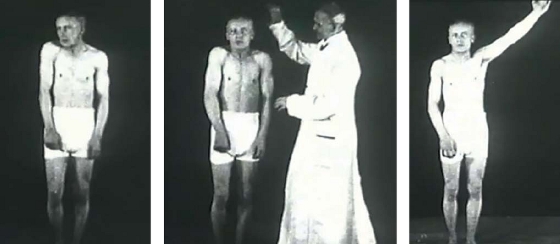“But it is also right that we had a people’s army that the man was forced to serve in the war that he wasn’t asked if he liked to go to war and you had to be prepared that people wanted to flee and the physicians played the part of machine guns behind the front, to repulse the fleeing.” (Sigmund Freud: Gutachten über die elektrische Behandlung der Kriegsneurotiker vom 14.10.1920 (trans.: Expertise on the use of electro shock therapy for war neurotics), quoted in: Riedesser/Verderber, p. 64)
This quote of Sigmund Freud illustrates the dilemma of the physicians during the First World War. On the one hand they were bound by their Hippocratic Oath to care for their patients the best they could. On the other hand the material battles of the First World War needed increasing numbers of soldiers and accordingly the army commands of the involved nations demanded the fastest possible recovery of the injured. In this context the medical sector of psychiatry was especially challenged. Because apart from the physical wound soldiers received during the First World War psychological diseases increasingly appeared. Especially on the western front where the soldiers had to endure hours and days of artillery bombardments more and more soldiers became mentally ill. The most common symptom was trembling at the whole body or individual extremities (source 1). Because of this in the German-speaking area the term of “Kriegszitterer” (trans.: war tremblers) became accustomed. The German psychiatric system couldn’t handle the large numbers of these combat stress reaction (CSR) patients. Even the diagnosis wasn’t easy what can be illustrated by the difference in nomenclature. Apart from the term of “war tremblers” the term of “war neurotics” and “war hysterics” was used while the British used the term “shell shock patients” (source 2). What was worse, trembling wasn’t the only symptom: muteness, deafness (temporary) blindness and many other symptoms also could occur (source 3). A precise number of the CSR patients cannot be named due to the difficult diagnosis and the fragmentary sources. It can be estimated that Germany had around 200,000 cases.
Max Nonne suggests a traumatized soldier under hypnosis that he doesn’t need to tremble.
(Scene from an educative movie from 1917, Deutsches Ärzteblatt 2012, H. 9, p. 407)
Felix Ruppricht, Dresden 2015
Bibliography- Wolfgang U. Eckert: Medizin und Krieg. Deutschland 1914 – 1924, Paderborn 2014.
- Fiona Reid: War Psychiatry, in: 1914-1918-online. International Encyclopedia of the First World War, URL: http://encyclopedia.1914-1918-online.net/article/war_psychiatry/2014-10-08, letzter Zugriff: 22.01.2014.
- Peter Riedesser und Axel Verderber: „Maschinengewehre hinter der Front“. Zur Geschichte der deutschen Militärpsychiatrie, 2. Aufl. Frankfurt am Main 2004.